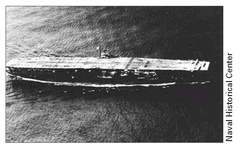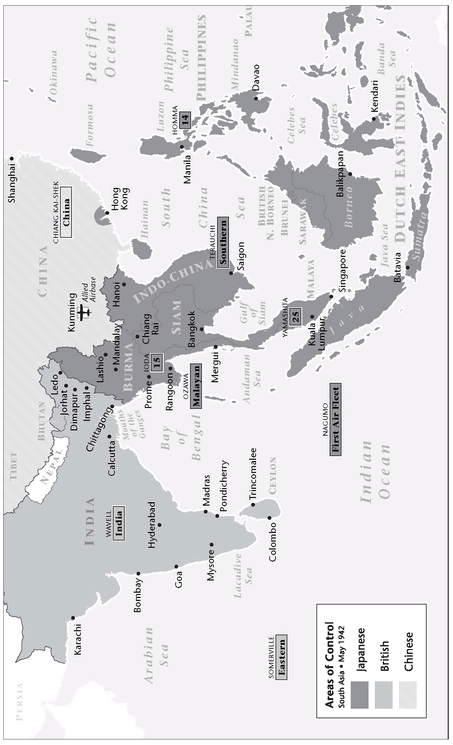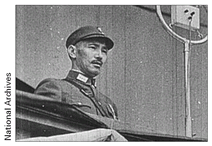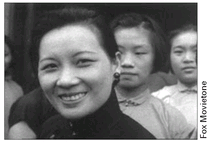War Stories II (26 page)
Authors: Oliver L. North

 ABOARD USS ENTERPRISE
ABOARD USS ENTERPRISE45 MILES EAST OF MIDWAY
4 JUNE 1942
2030 HOURS LOCAL
4 JUNE 1942
2030 HOURS LOCAL
At 1700 hours, twenty-four dive-bombers from the
Enterprise
and the
Yorktown
found the
Hiryu
about a hundred nautical miles west-northwest of the two remaining American carriers. The crew of the Japanese carrier, exhausted from a full day's fighting, had just started to eat when the first of four Dauntless bombs struck the carrier, instantly igniting an aviation gasoline tank on the hangar deck. The ship went up like a torch. By 1930 the
Kaga
and the
Soryu
were on the bottom.
Enterprise
and the
Yorktown
found the
Hiryu
about a hundred nautical miles west-northwest of the two remaining American carriers. The crew of the Japanese carrier, exhausted from a full day's fighting, had just started to eat when the first of four Dauntless bombs struck the carrier, instantly igniting an aviation gasoline tank on the hangar deck. The ship went up like a torch. By 1930 the
Kaga
and the
Soryu
were on the bottom.
Aboard the
Enterprise,
Admiral Spruance ordered the
Yorktown
's escorts to join the screen for the
Enterprise
and the
Hornet,
and then headed east to avoid a surface engagement with Yamamoto's battleships and cruisers.
AFTERMATHEnterprise,
Admiral Spruance ordered the
Yorktown
's escorts to join the screen for the
Enterprise
and the
Hornet,
and then headed east to avoid a surface engagement with Yamamoto's battleships and cruisers.
As darkness fell on 4 June, as Admiral Spruance withdrew to the east, Yamamoto canceled the order to take Midway and turned toward Japan with the entire Japanese Combined Fleet, taking advantage of the few remaining hours of darkness.
Â
Japanese aircraft carrier
AKAGI
AKAGI

When dawn broke on 5 June, the severely damaged
Yorktown
was still afloat. But Japanese destroyers sank their own
Akagi
and
Hiryu
with torpedoes just after first light. Admiral Nimitz, hopeful that
Yorktown
could make it back to Pearl Harbor's dry dock for repairs, ordered the vessel taken under tow.
Yorktown
was still afloat. But Japanese destroyers sank their own
Akagi
and
Hiryu
with torpedoes just after first light. Admiral Nimitz, hopeful that
Yorktown
could make it back to Pearl Harbor's dry dock for repairs, ordered the vessel taken under tow.
Later that day, two Japanese cruisers, the
Mikuma
and the
Mogami
, collided, trying to avoid torpedoes fired from an American submarine. On 6 June, aircraft from the
Enterprise
and the
Hornet
attacked these same two cruisers, still dead in the water. The
Mikuma
was sunk, but the
Mogami
managed to stay afloat and escape to Japan for repairs.
Mikuma
and the
Mogami
, collided, trying to avoid torpedoes fired from an American submarine. On 6 June, aircraft from the
Enterprise
and the
Hornet
attacked these same two cruisers, still dead in the water. The
Mikuma
was sunk, but the
Mogami
managed to stay afloat and escape to Japan for repairs.
That same day the Japanese submarine I-168 found the
Yorktown
as she was being towed slowly toward Hawaii. The destroyer
Hammann
had been lashed to the carrier's starboard bow to provide power and firefighting foam for damage-control parties struggling to save the vessel. When the I-168 fired a spread of four torpedoes at the damaged carrier, one of them struck the
Hammann
and she sank at once, taking most of her crew down with her.
Yorktown
as she was being towed slowly toward Hawaii. The destroyer
Hammann
had been lashed to the carrier's starboard bow to provide power and firefighting foam for damage-control parties struggling to save the vessel. When the I-168 fired a spread of four torpedoes at the damaged carrier, one of them struck the
Hammann
and she sank at once, taking most of her crew down with her.
The
Yorktown
stayed afloat until early on 7 June, when she finally succumbed and went down. When Yamamoto and Nimitz added up their gains and losses, the score looked like this:
Yorktown
stayed afloat until early on 7 June, when she finally succumbed and went down. When Yamamoto and Nimitz added up their gains and losses, the score looked like this:
| Japanese Losses | U.S. Losses |
|---|---|
| 4 carriers | 1 carrier |
| 1 heavy cruiser | 1 destroyer |
| 322 aircraft | 147 aircraft |
| 3,500 lives | 307 lives |
CHAPTER 7
THE FLYING TIGERS
(1937â1945)
L
ong before the successful battles of the Coral Sea and Midwayâwhen the tide of war began to change for the AlliesâAmericans had been fighting Japanese imperialism without the glare of the media spotlight. A small group of U.S. volunteersâan air force called the Flying Tigersâhad been helping the Chinese in their skirmishes with the Japanese since 1938. Few Americans knew very much about them until five months after Pearl Harbor, following the Doolittle Raid.
ong before the successful battles of the Coral Sea and Midwayâwhen the tide of war began to change for the AlliesâAmericans had been fighting Japanese imperialism without the glare of the media spotlight. A small group of U.S. volunteersâan air force called the Flying Tigersâhad been helping the Chinese in their skirmishes with the Japanese since 1938. Few Americans knew very much about them until five months after Pearl Harbor, following the Doolittle Raid.
When Jimmy Doolittle planned that first American air raid against Japan, he hoped that his sixteen B-25 aircrews would be able to land safely in China on airfields controlled by Chiang Kai-shek's National Chinese Army. It was a logical assumption. Chiang was an American ally in the war against Japan and had been fighting the Imperial Army since soldiers marching beneath the banner of the Rising Sun had invaded his homeland in 1931. Better still from Doolittle's perspective, a good number of American “advisors” were also in Chinaâand many of them had been there for years.

Most histories mark the start of World War II as 1 September 1939, when Adolf Hitler's legions invaded Poland, but Chiang and the Chinese people knew better. For them, the bloodiest conflict in history began in September 1931, when the Japanese Imperial Army marched into coal- and iron-rich Manchuria and occupied Mukden, the provincial capital, on the pretext that the troops had come to protect a Japanese-built railroad.
The Chinese government in Peking (now Beijing), a signatory to the League of Nations charter, protested the Japanese incursion and called on the international community for help. Distracted by the global economic disruptions of the Great Depression, the League took the matter “under consideration.” Tokyo's response to this vacillation was a demand that “all Chinese associations of an anti-Japanese nature” be disbanded. On 28 January 1932, when the Chinese government refused, Japanese troops landed at Shanghai.
Though lacking aircraft or tanks, the Chinese put up a spirited defenseâand again appealed to the League of Nations. While the diplomats dithered, Tokyo set up a puppet regime in Mukden, renamed the entire territory “Manchukuo,” and claimed that Japanese troops would remain at the request of the government of this new and “independent” state. The League of Nations responded by censuring Tokyo and demanding the withdrawal of Japanese troops. Japan promptly withdrew from the League.
Realizing that they could act in China with virtual impunity, unhindered by intervention from the rest of the world, the Japanese began a methodical troop buildup on the Chinese mainland. By March 1933, they had annexed the Chinese province of Jehol and Japanese troops had penetrated all the way to the Great Wall.
For the next four years, much of what Americans knew about events in China came less from newspapers or radio than it did from their churches. American missionaries of every Christian denomination had been flooding into China and building churches, schools, hospitals, and orphanages
for decades. Now the correspondence between those religious institutions in China and their counterparts in the United States coupled spiritual matters with what was happening to the Chinese people, caught in the crossfire of a civil war and menaced by the increasingly hostile Japanese.
for decades. Now the correspondence between those religious institutions in China and their counterparts in the United States coupled spiritual matters with what was happening to the Chinese people, caught in the crossfire of a civil war and menaced by the increasingly hostile Japanese.
Many letters and telegrams from China in the early 1930s describe the fight between the revolutionaries led by Mao Tse-tung and the Nationalist followers of Generalissimo Chiang Kai-shek as a struggle between godless Communism and the future of Christianity in the world's most populous country. It was a description that Chiang sought to exploit as he looked for help contending with Mao and the Japanese.
In this effort, the Nationalist leader had a formidable ally. His beautiful wife, Soong Mei-ling, known to the rest of the world as Madame Chiang, was the American-educated daughter of a Christian missionary. A graduate of Wellesley College, fluent in English, with considerable connections in Washington, she dispatched a constant stream of letters and telegrams to friends in the United States begging for help against the Communists and the Japanese.
Â
General Chiang Kai-shek

By the summer of 1937, Chiang and Mao had negotiated an uneasy truce between the Nationalists and the Communists. The military government in Tokyo, believing that a “united China” posed a threat to their plans for a “Greater East Asia Co-Prosperity Sphere,” decided it was time to act. On 7 July, they ordered a full-scale invasion, claiming that Japanese nationals in Peking were at risk in the continuing civil disorder.
Just days before the assault, Madam Chiang and the Generalissimo had met with Claire Chennault, a recently retired American airman. The forty-five-year-old Chennault had been medically retired for chronic bronchitis and deafness from flying in open-cockpit fighters. Arriving in May, via a stop in Japan, he had come to China at the suggestion of a friend who wanted advice on how to help the Chinese build a decent air force.
Chennault was appalled by what he found. Though the Chinese showed more than 500 fighters, transports, and bombers on their rolls, in reality they had only ninety-one aging, second-rate aircraft. With characteristic bluntness, he told the Nationalist leader and his wife that they needed his helpâand that of the United States. They hired him on the spot to provide that assistance. But before he could even begin, the Japanese invaded.
Â
Madame Chiang Kai-shek

The next five months were a fury of activity for Chennault as he tried to build an air force worthy of taking on the Japanese invaders. As Chinese troops gave ground grudgingly, the new American advisor to the Nationalist government tried to mold the chaotic Chinese air arm into a real fighting force. Lacking everything from repair facilities to spare parts to decent flight instructors, Chennault reached out to colleagues he had known for years in the Army Air Corps. Some were already in China. Others, responding to the call of an old friend, came from the Statesââeven though FDR had signed the Neutrality Act into law in May, just about the time Chennault arrived in China.
Other books
Honor's Players by Newman, Holly
The Mortal Instruments - Complete Collection by Cassandra Clare
The Scarred Man by Basil Heatter
The Impossible Governess by Margaret Bennett
The Funeral Dress by Susan Gregg Gilmore
The Amish Bride of Ice Mountain by Kelly Long
Desirable by Elle Thorne, Shifters Forever
La vuelta al mundo en 80 días by Julio Verne
The Art of Intrusion: The Real Stories Behind the Exploits of Hackers, Intruders and Deceivers by Kevin D. Mitnick, William L. Simon
Twisted by Laura Griffin
